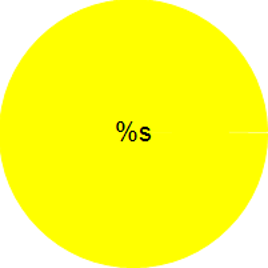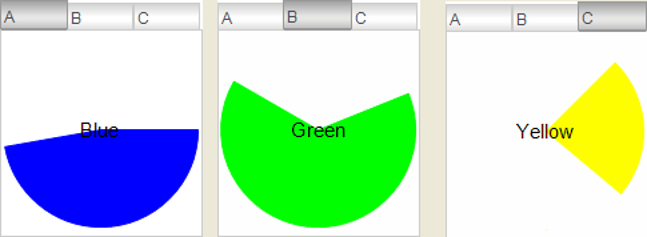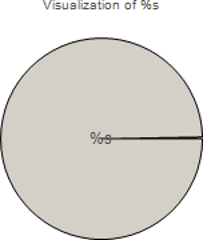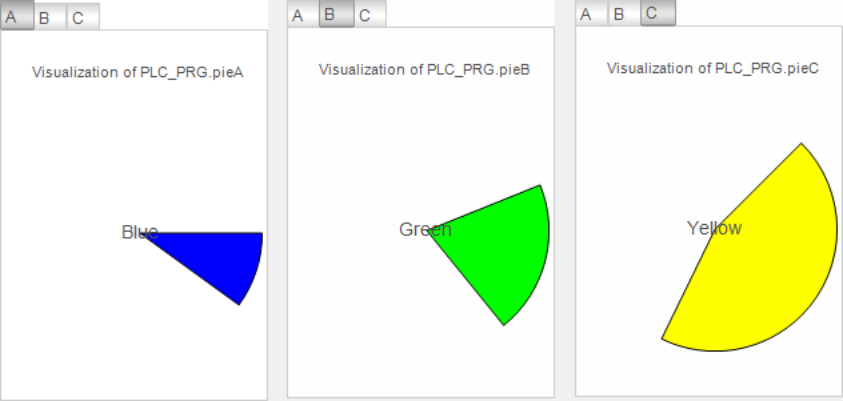You can declare an interface for parameters for a visualization that is to be referenced. The actual parameters are passed to the interface (similar as in the case of a function block) when the visualization is called at runtime.
First of all, declare the interface variables in the visualization interface editor. Then configure the parameters that are transferred to the interface by assigning a data-type-compliant application variable to each interface variable. The assignment is configured in the “References” property in the case of a “Frame” or a “Tabs”.
Depending on the display variant, the parameter transfer of local variables (with
the VAR scope) is limited. If you execute the visualization as an integrated visualization,
you can only transfer local variables having a basic data type as parameters. If the
visualization is called as CODESYS TargetVisu or CODESYS WebVisu, then you can also transfer parameters with a user-defined data type.
User-controlled update of the transfer parameters
If you have configured visualization references and then save a change to the variable declaration for one of these visualizations in an interface editor, then the “Updating the Frame Parameters” dialog appears automatically. The dialog prompts you to edit the references. A list of all the visualizations affected is displayed there, so that the parameter transfers can be reassigned at the changed interface.
When the dialog is closed, the changes are accepted and the elements affected are displayed in the “References” property.
Calling visualization with interface (VAR_IN_OUT)
Requirement: The project contains a visualization and a main visualization. The main visualization contains an element that the visualization references.
-
Open the visualization.
-
Click “Visualization Interface Editor”.
-
Declare a variable in the interface editor.
The visualization has an interface and the “Updating the Frame Parameters” dialog appears.
-
Assign a type-compliant transfer parameter to the interface variables in all calls by entering an application variable in “Value”. Close the dialog.
A transfer parameter is assigned at the points where the visualization is to be referenced. These now appear in the main visualization in the “References” property.
Example
The visPie visualization contains an animated, colored pie. The visMain main visualization calls the visPie visualization multiple times in a “Tabs” control. Color information, angle information, and label are transferred via the
pieToDisplay interface variable. The pies vary at runtime.
Visualization visPie:

|
“Variable for begin” |
|
|
“Variable for end” |
|
|
“Texts Text” |
%s |
|
“Text variables Text variable” |
|
|
“Color variable Normal state” |
|
Interface of the visualization visPie:
VAR_IN_OUT pieToDisplay : DATAPIE; END_VAR
Main visualization visMain:
|
“References” |
|
|
“visPie” |
|
|
“Heading” |
|
|
|
|
|
“visPie” |
|
|
“Heading” |
|
|
|
|
|
“visPie” |
|
|
“Heading” |
|
|
|
|
DATAPIE (STRUCT)
TYPE DATAPIE : // Parameter type used in visPie STRUCT dwColor : DWORD; // Color data iStart : INT; // Angle data iEnd : INT; sLabel : STRING; END_STRUCT END_TYPE
GVL
{attribute 'qualified_only'}
VAR_GLOBAL CONSTANT
c_dwBLUE : DWORD := 16#FF0000FF; // Highly opaque
c_dwGREEN : DWORD := 16#FF00FF00; // Highly opaque
c_dwYELLOW : DWORD := 16#FFFFFF00; // Highly opaque
c_dwGREY : DWORD :=16#88888888; // Semitransparent
c_dwBLACK : DWORD := 16#88000000; // Semitransparent
c_dwRED: DWORD := 16#FFFF0000; // Highly opaque
END_VAR
PLC_PRG
PROGRAM PLC_PRG VAR iInit: BOOL := TRUE; pieA : DATAPIE; // Used as argument when visPie is called pieB : DATAPIE; pieC : DATAPIE; iDegree : INT; // Variable center angle for the pie element used for animation END_VAR IF iInit = TRUE THEN pieA.dwColor := GVL.c_dwBLUE; pieA.iStart := 0; pieA.sLabel := 'Blue'; pieB.dwColor := GVL.c_dwGREEN; pieB.iStart := 22; pieB.sLabel := 'Green'; pieC.dwColor := GVL.c_dwYELLOW; pieC.iStart := 45; pieC.sLabel := 'Yellow'; iInit := FALSE; END_IF iDegree := (iDegree + 1) MOD 360; pieA.iEnd := iDegree; pieB.iEnd := iDegree; pieC.iEnd := iDegree;
Main visualization visMain at runtime:

Printing the instance name of a transfer parameter
In order to obtain and output the instance name of a transfer parameter, you can implement
an interface variable (data type STRING) with the pragma {attribute 'parameterstringof'} in the VAR_INPUT scope.
The project contains a visualization and a main visualization. The main visualization contains elements that the visualization references.
-
Open the visualization.
-
Click “Visualization Interface Editor”.
-
Declare an interface variable (
VAR_IN_OUT).pieToDisplay : DATAPIE; -
In the interface editor, declare a variable (
VAR_INPUT) with attribute{attribute 'parameterstringof'}.{attribute 'parameterstringof' := 'pieToDisplay'}sNameToDisplay : STRING; -
Save the changes.
The “Updating the Frame Parameters” dialog does not open.
-
Insert a “Text Field” element.
-
In the “Texts”, “Text” property, assign an output text to the text field.
Visualization of %s -
In the “Text variables”“Text variable” property, assign the interface variable to the text field.
sNameToDisplayvisPiehas a heading.
Example
The visPie visualization consists of one pie until now. The visMain main visualization calls visPie in a “Tabs” control three times with different transfer parameters.
The visPie is extended with a text field that outputs the name of the parameters actually passed
to the visualization. For this, the interface of visPie is extended with a string variable that contains the instance name of the specified
transfer parameter. At runtime, each pie is overwritten.

|
“Texts”, “Text” |
|
|
“Text variables”, “Text variable” |
|
Interface of the 'visPie' visualization:
VAR_INPUT
{attribute 'parameterstringof' := 'pieToDisplay'}
sNameToDisplay : STRING;
END_VAR
VAR_IN_OUT
pieToDisplay : DATAPIE;
END_VAR
Main visualization visMain at runtime:







